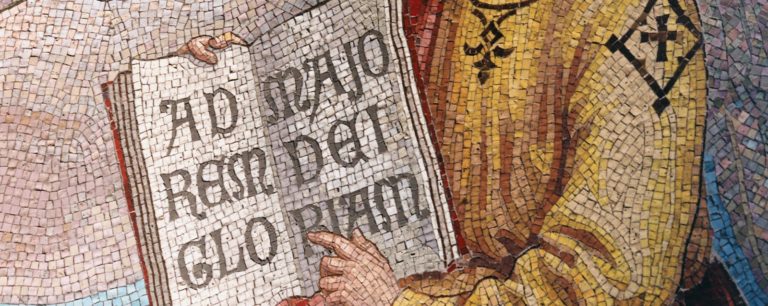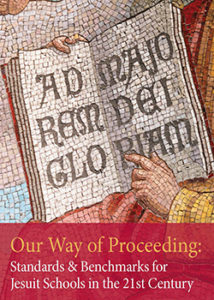
Ignatius didn’t plan on establishing schools, at least not initially. He first wanted to travel to the Holy Land to “save souls,” but when that plan fell through, he and his companions decided to turn to other ministries such as education. Nearly five centuries later, their choice turned out to be fortuitous, for Jesuit schools rank as some of the best in the world.
Much of this success is due to Ignatius’s approach to pedagogy. His work in spiritual direction gave him great insight into the human person, and these insights later informed his approach to education, which has proven remarkably adaptable over the years as Jesuit schools respond to ever-changing contexts.
Newcomers to Jesuit education need not jettison everything they’ve ever learned about teaching. In all likelihood they’ve been practicing some of these techniques already. Ignatian pedagogy is meant to help such teachers be more intentional about these good educational practices while also supplementing them with new ones. The sections below explain how teachers can do so as they begin working in a Jesuit institution and how they can hone their craft as they become experienced Ignatian educators.
Beginner
Teachers who are new to Ignatian pedagogy can find a great introduction in the Jesuit Secondary Education Association’s Foundations. Although almost 30 years ago, the document still has useful advice for how to teach students in the 21st century. The Preamble offers a concise introduction that touches on many key themes in Jesuit education, including being contemplatives in action, engaging our society and our world with a critical eye, and achieving not only academic excellence but a true metanoia. (*Please note that the 4-page Preamble should not be confused with the Foreword or with the two Prefaces that precede it.)
Another helpful introduction is “A Pocket Guide to Jesuit Education” produced by Boston College.
Newer teachers should also review the Profile of the Graduate of a Jesuit High School at Graduation, (*section 8 of the Foundations document). Commonly referred to as the “Grad at “Grad,” this text identifies the five key characteristics every graduate of a Jesuit high school should embody. A similar description of the ideal teacher can be found in the “Profile of an Ignatian Educator.” Also important is the concept of “cura personalis,” which emphasizes attending to the care of each individual person, especially in a holistic manner. For brief explanations of this concept, please see the two videos below.
Once teachers have become more familiar with these foundational principles, they should examine the Ignatian Pedagogical Paradigm (section 14 of the Foundations document). They will likely find that they are already using many of these elements in their instruction, but the structure outlined in the paradigm can further bolster their teaching.
After studying many of these abstract concepts – yet before trying them out in the classroom – teachers might find helpful the ten vignettes in Ralph Metts’s Ignatius Knew on pages 117-122. These brief sketches of various classroom activities are guided by Ignatian pedagogical principles, and it would be helpful to see how many of these principles teachers can identify.
Intermediate
Teachers familiar with the Igantian Pedagogical Paradigm will find several commonalities with the “Four Hallmarks of Jesuit Pedagogy” (section 13 of the Foundations document). The text can be dry and very theoretical at times, but it outlines four useful techniques for educating young people: prelection, reflection, active learning, and repetition.
Teachers looking for a more in-depth view on cura personalis should see the article written by a former Superior General of the Jesuits: Peter Hans-Kolvenbach, “Cura Personalis,” Review of Ignatian Spirituality 114 (2007): 9-17.
Veteran teachers should also seek out opportunities to participate in meetings with fellow educators hosted by their province, meetings hosted by the Jesuit Schools Network, and events geared toward students such as the Ignatian Family Teach In held annually in Washington, DC.
Advanced
 Teachers with ample experience in Jesuit education should read “Our Way of Proceeding: Standards & Benchmarks for Jesuit Schools in the 21st Century.” The pamphlet is concise but very dense, outlining 15 key standards every Jesuit school should aspire to, and many of these pertain to the work of Ignatian educators.
Teachers with ample experience in Jesuit education should read “Our Way of Proceeding: Standards & Benchmarks for Jesuit Schools in the 21st Century.” The pamphlet is concise but very dense, outlining 15 key standards every Jesuit school should aspire to, and many of these pertain to the work of Ignatian educators.
A precursor to the above text yet one with enduring validity today is “Go Forth and Teach: The Characteristics of Jesuit Education” (section 10 of the Foundations document). Although a bit dated, it provides a more thorough treatment of this topic than other texts recommended on this page while still offering plenty of insight for modern educators.
For a series of taped lectures on various Ignatian topics, see the White House Lecture Series. Some of the videos focus on pastoral or spiritual topics, while some are more academic.
Experienced teachers looking for more of a leadership role in Ignatian education should also consider the Seminars in Ignatian Leadership offered through the Jesuit Schools Network.
